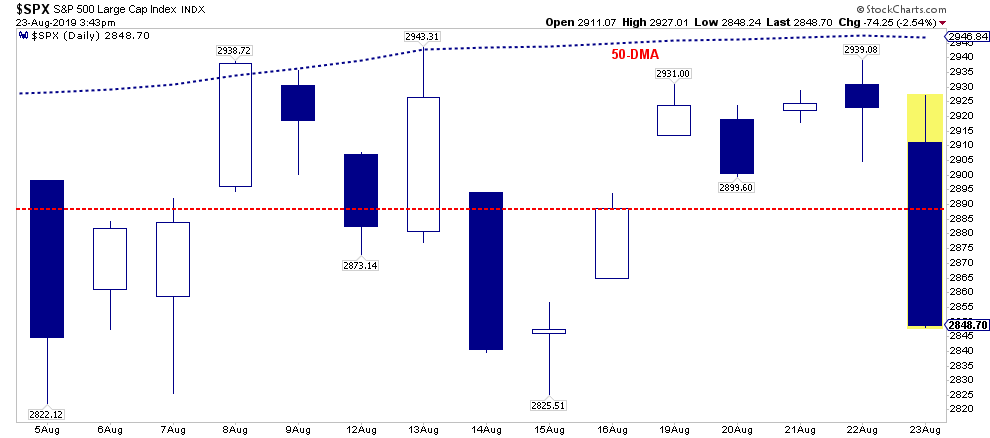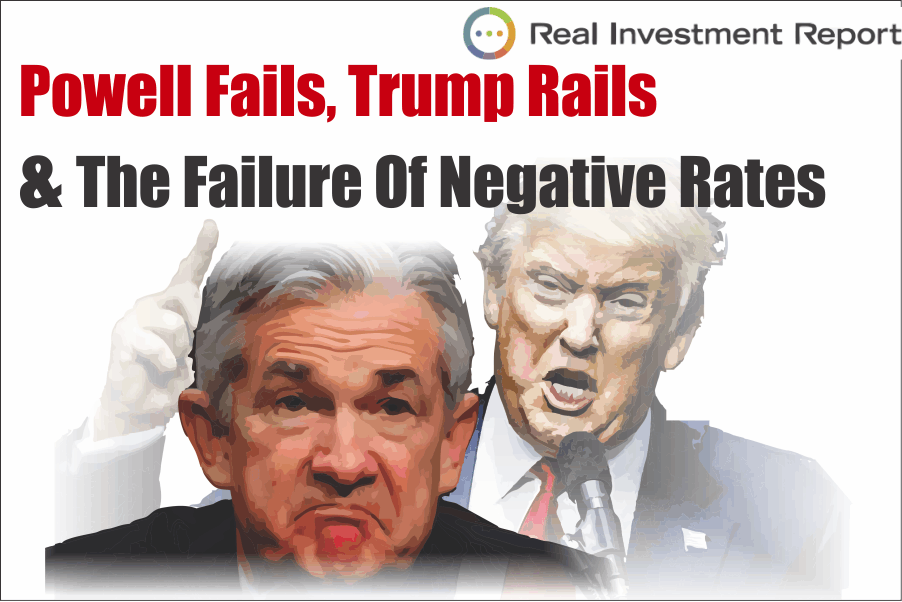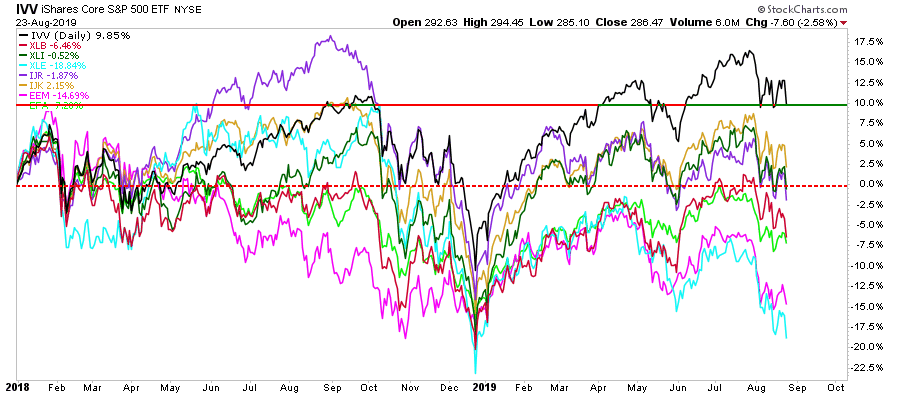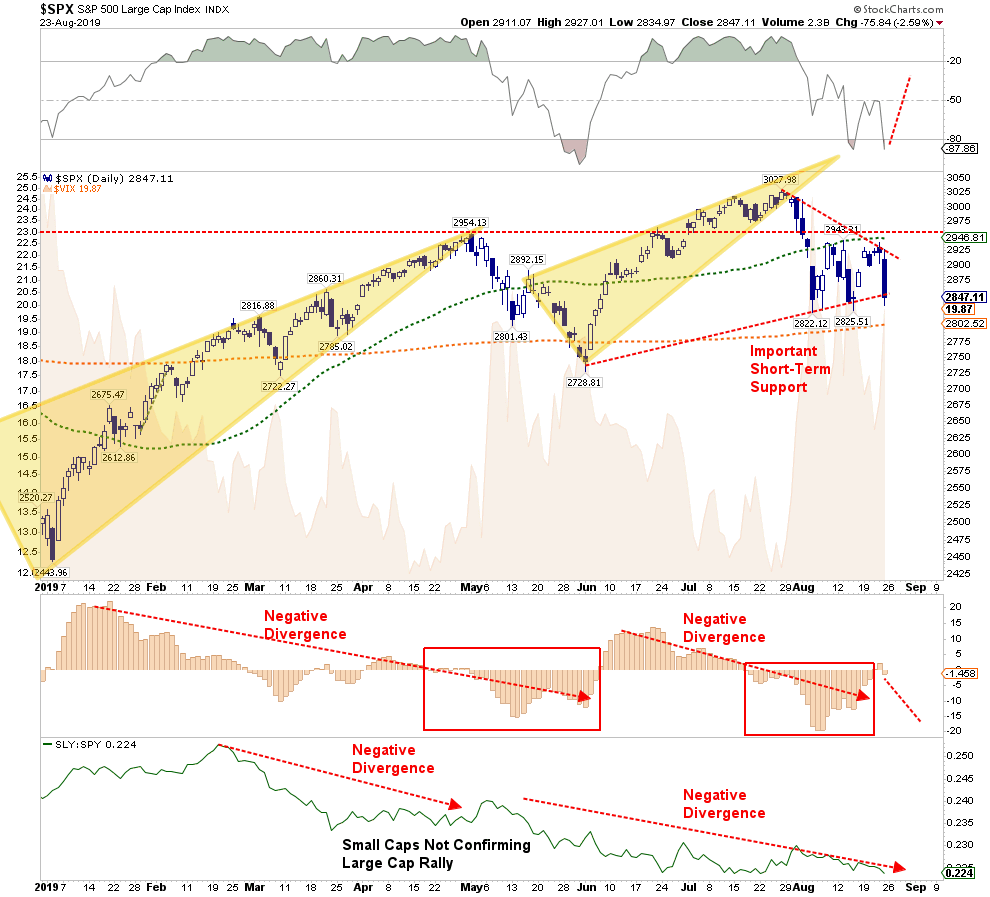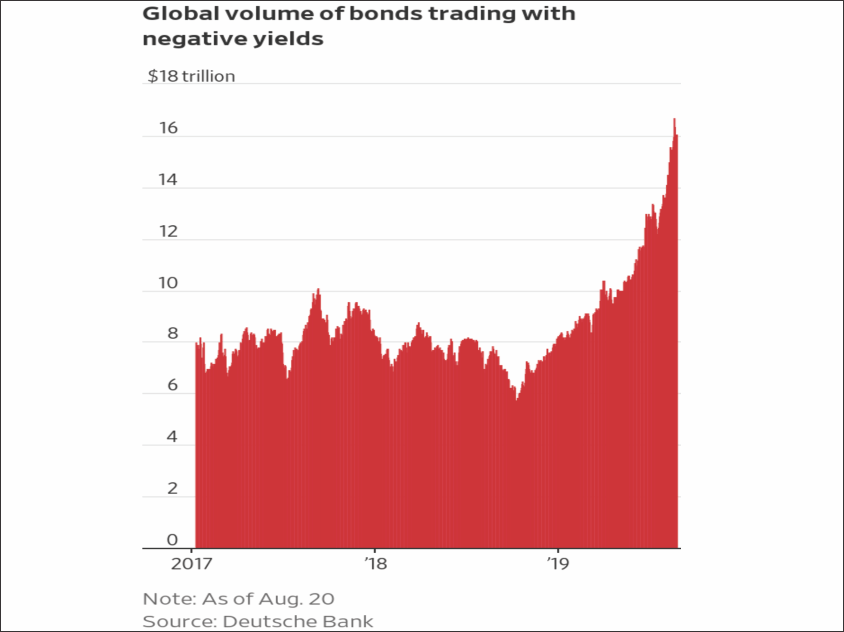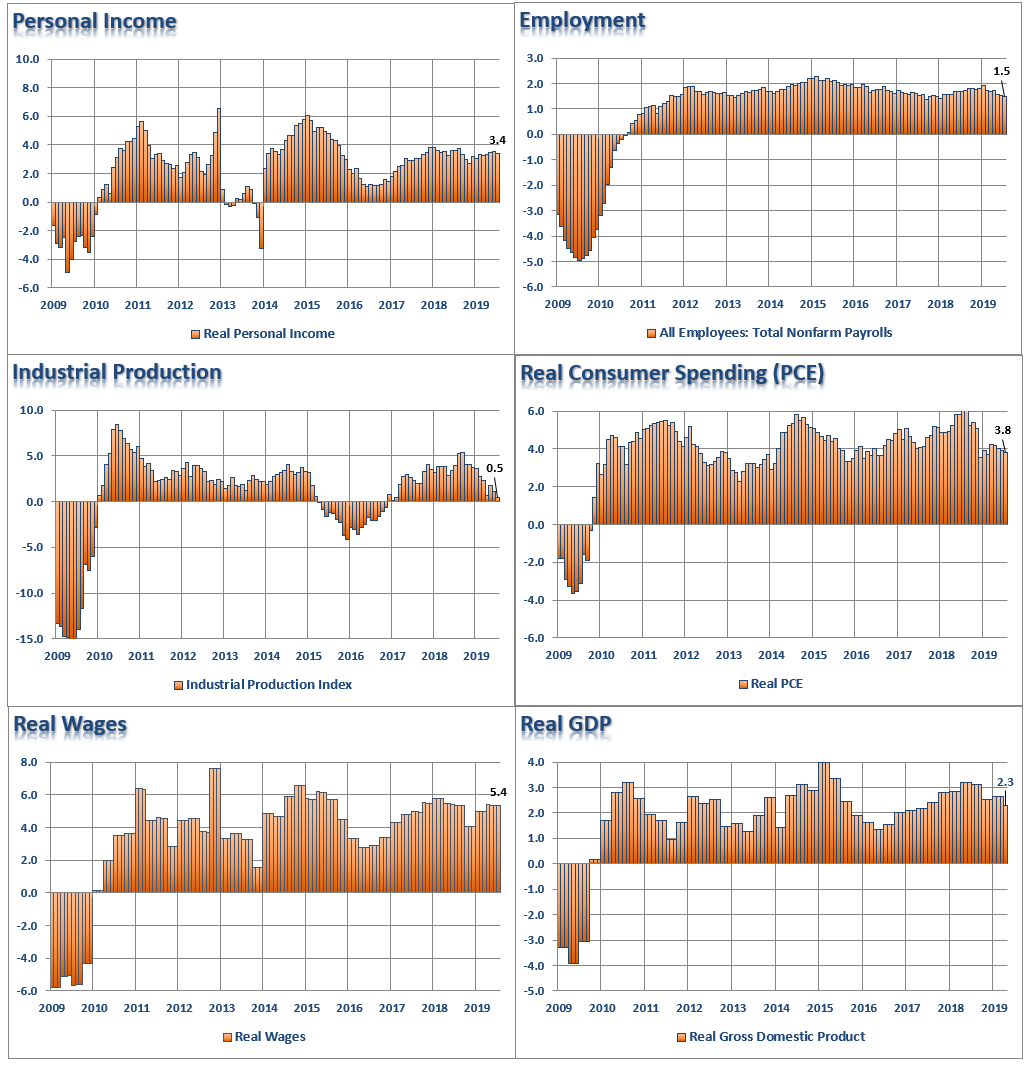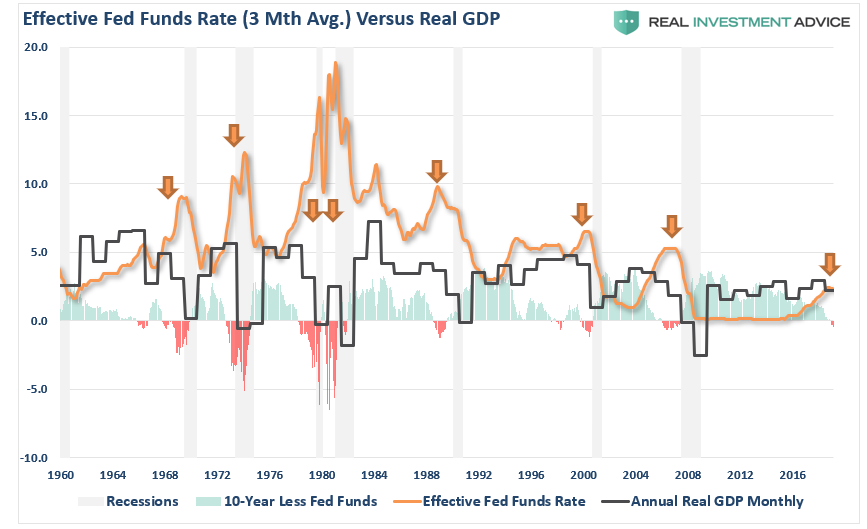Authored by Lance Roberts via RealInvestmentAdvice.com,
Trump & Powell Square Off
Let’s start with a simple chart:
This has been an impossible market to effectively trade as rhetoric between the White House, the Fed, and China, has reached a fevered pitch.
On Friday, several things happened which have at least temporarily significantly heightened market risk.
Jerome Powell disappointed the markets, and the White House, by sticking with their previous guidance concerning monetary policy actions. To wit:
-
We Will Act As Appropriate To Sustain The Expansion (Will cut rates if needed)
-
Says Events Since The July Fomc Have Been `Eventful’ (Trade War/Tariffs)
-
Carefully Watching Development For Impact On U.S. (China/US Trade)
-
Monetary Policy Has No Rulebook For International Trade
-
We’ve Seen Further Evidence Of A Global Slowdown (Germany in recession)
-
Fitting Trade Policy Into Risk-Management Framework Is a New Challenge
-
Fed Faces Heightened Risk of Difficult-to-Escape Periods of Near-Zero Rates (Neg. rates)
-
U.S. Economy Has Continued to Perform Well Overall (No rush to cut rates)
-
Sees Financial Stability Risks as Moderate, but Will Remain Vigilant
However, this commentary was not a surprise to us. We have suggested for several months the Fed should be slow to use what little ammo they currently have.
“With the markets pushing record highs, recent employment and regional manufacturing surveys showing improvement, and retail sales rebounding, it certainly suggests the Fed should remain patient on cutting rates for now at least until more data becomes available. Patience would also seem logical given the limited room to lower rates before returning to the ‘zero bound.’”
Not surprisingly, Chairman Powell’s comments did not sit well with President Trump who has frequently pressed the Fed to cut rates aggressively. Mr. Powell stopped short of promising any specific monetary-policy easing, saying instead the central bank would “act as appropriate.”
“After Powell’s closely watched speech in Jackson Hole, Trump tweeted, ‘As usual, the Fed did NOTHING!’
After China announced more import tariffs on U.S. goods early Friday, Trump said he would respond Friday afternoon. The president also asked ‘who is our bigger enemy,’ Powell or Chinese President Xi Jinping.” – MarketWatch
By the end of the day on Friday both the U.S. and China had hiked tariffs on one another.
“China said it would increase existing tariffs by 5% to 10% on more than 5,000 U.S. products, including soybeans, oil, and aircraft. A 25% duty on American-made cars would also be reinstituted. The value of these products is estimated by the Chinese Commerce Ministry to total around $75 billion.
Trump responded after financial markets closed by saying he would raise current U.S. tariffs. A 10% duty on $300 billion in Chinese goods will be raised to 15% in September while a 25% tariff on $250 billion in imports would be increased to 30% in October.” – MarketWatch
The Investing Conundrum
The problem with managing money is that markets are now trading on “tweets,” and “headlines,” more than fundamentals. This makes being either long, or short, particularly difficult.
This was a point made earlier this week to our RIAPRO subscribers:
With the volatility seen in just the past two weeks, it is too difficult to trade short positions without being ‘whipsawed’ out of the holdings.
Trading Rule:
When you are ‘unsure’ about the best course of action, the best course of action is to ‘do nothing.’”
This is where we are currently.
Over the past few months we have reiterated the importance of holding higher levels of cash, being long fixed income, and shifting risk exposures to more defensive positions. That strategy has continued to work well.
-
We have remained devoid of small-cap, mid-cap, international and emerging market equities since early 2018 due to the impact of tariffs on these areas.
-
For the same reasons we have also reduced or eliminated exposures to industrials, materials, and energy
-
With the trade war ramping up, there is little reason to take on additional risk at the current time as our holdings in bonds, precious metals, utilities, staples, and real estate continue to do the heavy lifting.
If you are being advised to hold all these asset classes for “diversification” reasons, you should be asking yourself, “why?”
Trade wars, and tariffs, are not friendly to these markets. With those “taxes” being ramped up by both parties, things will get worse, before they get better.
Risk management is critically important to long-term returns, and risk is becoming more elevated daily. So, if you are paying for a “buy and hold” portfolio, you may want to reconsider what you are paying for?
From a technical perspective, the market is back to oversold, so a bounce next week is possible, but as noted last week, this is “still a sellable rally.” However, if the market breaks the current consolidation to the downside, a test of the 200-dma will be critically important. Any failure at that support will bring the December lows back into focus.
As we have continued to note over the last few weeks, the ongoing deterioration of small and mid-capitalization companies continues to suggest the overall backdrop of the markets is not healthy.
We continue to remain cautious for the time being.
Negative Yields Everywhere
As I noted last week in “Pavlov’s Dogs & The Ringing Of The Bell:”
“The ‘ringing of the bell’ over the last decade has trained investors to rush into equity-related risk.”
With Powell disappointing traders, and Trump retaliating with additional tariffs, the initial response was to flee to “safety,” or rather should I say ” bonds.”
While retail investors continue to cling onto stocks hoping for a resurgence of the “bull market,” institutions are piling into bonds as the tidal wave of data continues to warn something is “broken.”
(You don’t have $17 Trillion in negative-yielding sovereign debt if there is economic and fiscal stability.)
Doug Kass reminded me on Thursday of a memorable lesson from “Wall Street.”
“Quick buck artists come and go with every bull market, but the steady players make it through the Bear Markets. Enjoy it while it lasts – ’cause it never does.’” – Lou Mannheim
The message that negative yields are sending coincides with weaker growth rates in:
-
Corporate profits
-
Employment
-
CapEx
-
Personal Consumption Expenditures
-
Real Retail Sales
-
GDP
You can see this visually in the 6-panel chart from last week’s missive
Yes, the data is not negative which is why we aren’t in a recession…yet, (However, the data is subject to substantial negative revisions, and as we showed last week, the month before the last recession started all the data was positive as well.)
This is also the reason the Fed stopped hiking rates.
Last September, the Fed believed they needed to hike rates more aggressively as they believed the “neutral rate,” (code for economic growth) was considerably higher. We warned then several natural disasters were skewing the economic data, and that hiking rates was a mistake. By December, as rates reached 2%, and with the markets down 20%, the “neutral rate” had been achieved.
Don’t mistake the following comment from Fed member Patrick Harker earlier this week:
“This was a situation where we were getting back to what I would see as a neutral rate. In December 2018, we raised rates by 25 basis points. At that time, I was not supportive of that move because I thought that we didn’t need to do that. So, we’re just recalibrating back to where I thought we should have been, with a 25-basis-point cut.”
Since that is a lot of “Fed speak,” let me translate:
“Listen, as a member of the Fed, I can’t tell you the economy has weakened significantly, and the threat of a recession has risen markedly. If I did say that, the market would crash, consumer confidence would crash, and we would immediately be in a recession.
The reality is that we needed to get rates off of zero percent, and we were hoping to get rates closer to 4%, to give us some room to support the economy during the next recession.Unfortunately, we actually ‘over tightened’ which led to the market disruption last year. The rate cut in July was to be supportive of the economy short-term, but we need to hold as much ‘ammo’ as possible in reserve for when the recession hits.”
Here is a chart of the Effective Fed Funds Rate versus the Neutral Rate (Real GDP):
You should note a couple of things.
-
It wasn’t until the 1990’s that the “neutral rate” became a thing. However, one of the best indicators of an impending recession is when the 10-year rate is inverted to the Fed Funds rate, as it is now.
-
The indicator is even more timely when the curve is inverted combined with the Fed cutting rates, as they are now.
Could this time be different? Absolutely, there is always the possibility this time could be different. However, betting on possibilities versus probabilities tends not to work out well.
Why The Fed Won’t Go Negative
Since the Fed meeting in July when they cut rates by 0.25%, the Fed has been working diligently to lower expectations of further rates cuts. As noted, this is because the Fed understands the trap they have gotten themselves into.
-
With just a bit more than 2% between the current Fed funds rate and ZERO, the Fed understands what little bit of precious ammo they have to fend off the next recession.
-
They won’t go “negative” on rates.
Concerning the second point, my colleague Daniel LaCalle summed it up well:
“The paper ignores the collapse in net income margin and ROE and even dismisses ROTE (return on tangible equity) to try to defend the idea that banks earnings have not suffered from negative rates.
The worrying part is that these statements ignore the fact that one of the main reasons why banks’ bottom line has not fallen more is they have almost stopped making provisions on bad loans.“
His point is critically important.
Negative rates have irreparably damaged European banks, which only can be resolved through a massive debt revulsion.
The Fed is at least smart enough to understand this dynamic, which is why they are defending what room they have with the one rate they can directly control.
Wolf Richter also had some excellent points in this regard:
“Negative interest rates drive banks to chase yield to make some kind of profit. So they do things that are way too risky and come with inadequate returns. For example, to get some return, banks buy Collateralized Loan Obligations backed by corporate junk-rated leveraged loans. In other words, they load up on speculative financial risks. And as this drags on, banks get more precarious and unstable.
This is not a secret. The ECB and the Bank of Japan and even the Swiss National Bank have admitted that negative interest rates weaken banks. The ECB has even been talking about a strategy to ‘mitigate’ the destructive effects its policies have on the banks.
So that’s the issue with negative interest rates and banks. They crush banks.”
Don’t forget.
Why did the Fed launch Q.E., and cut rates to zero, to begin with?
To bail out the member banks of the Federal Reserve, or should I just say, “Wall Street.”
Interest rates are a function of economic growth. Globally, despite massive levels of QE, and low interest rates, economic growth is faltering, not strengthening.
The Fed does understand this.
Unfortunately, the Fed is still misdiagnosing what ails the economy, and monetary policy is unlikely to change the outcome in the U.S., just as it failed in Japan. The reason is simple. You can’t cure a debt problem with more debt. Therefore, monetary interventions, and government spending, does not create organic, sustainable, economic growth.
Simply pulling forward future consumption through monetary policy continues to leave an ever growing void in the future that must be filled. Eventually, the void will be too great to fill.
If rates ever do rise, it’s game over as borrowing costs surge, deficits balloon, housing falls, revenues weaken, and consumer demand wanes. It is the worst thing that can happen to an slow growing economy that is dependent of further debt expansion just to sustain current growth.
As Wolf noted, lower rates are not the solution, they are the problem.
“So far, the outcomes are already bad, and now, because the outcomes are already bad, they’re wanting to drive interest rates even lower to deal with the bad outcomes that these low interest rates have already caused.”
via ZeroHedge News https://ift.tt/2PabbsP Tyler Durden
